Versioning RESTful Web Services-Basic Approach With URIsVersioning is the most important and difficult part of the API as it takes backward API compatible. Versioning helps us to iterate faster when the changes are identified. We should always version our Web API. Consider a scenario in which we have a Web API that is up (status) and running. The users are consuming that API. Now we want to add more functionality in the Web API but want to keep the existing functionality unchanged. There may be few users who still want to use the old API while the other users want a new version of API with new or extended features. It is the scenario where Web API versioning comes into existence. When we required versioning:When we made a breaking change in Web API, we should up versioned the API. Breaking changes includes:
Breaking changes should always result in a change to the major version number for an API or content response type. Non-breaking changes (adding new points or new response parameters) do not require a change to the major version number. However, it can be helpful to track the minor version of the APIs. How to VersionThe most commonly used approaches fall into three categories:
URI VersioningURI versioning is the most straightforward approach. It specified in the URL as a query string. It violates the principle that a URI should refer to a unique resource. You are also guaranteed to break client integration when a version is updated. Twitter uses URI versioning. Example http://api.demo.com/v1 The version need not be numeric, nor specified using v[x] syntax. Alternatives include the date, project name, season, or other identifiers that are meaningful enough to change as the version change. Versioning using Custom Request HeaderA custom header allows us to preserve our URLs. It is a duplicate of the content negotiation behavior implemented by the existing Accept header. Version information is specified in the Request Header without the need for any change in the URL. Microsoft uses the request header versioning. The user cannot access request header versioning in the normal browser (chrome). We are required a special plugin to access them on the browser. Example Accept-version: v1 Versioning using Accept HeaderAccept header define the media type and character encodings. We can also pass version information for Web API through accept headers without changing the URL. It is also known as media type versioning or content negotiation or accept header. Github uses the accept header versioning. The user cannot access accept-header versioning in the normal browser (chrome). We are required a special plugin to access them on the browser. Example Accept: application/vnd.demo.v1+json Accept:application/vnd.demo+json;version=1.0 Let's see how to implement versioning in the project. URI VersioningStep 1: Create a class with the name PersonV1.java in the package com.javatpoint.server.main.versioning. PersonV1 denotes the first version of API. The initial version of API has a name variable. PersonV1.java Step 2: Over a period, we recognize the need for having the first name and last name separately. So we created a class with the name Person2.java. It denotes the second version of API. PersonV2.java Step 3: Create a class with the name Name.java that has two variables firstName and lastName separately. Name.java The old version is still returning the full name, and the second version is returning firstName and lastName separately. Now we are required to create two different versions of the same service. Let's see how to create two different versions of the same service and what are the different versions of the service are present. Step 4: In the Name.java file, Generate Getters and Setters, Generate Constructor using Fields. Create a no-argument constructor of the class Name. Name.java Step 5: Open PersonV1.java class. Generate Getters and Setters, Generate Constructor using Fields. Create a no argument constructor of the class PersonV1.java. PersonV1.java Step 6: Open PersonV2.java. Generate Getters and Setters, Generate Constructor using Fields. Create a no argument constructor of the class PersonV2.java. PersonV2.java Now we need to create a service. Step 7: Create a class with the name PersonVersioningController.java. Create two methods for different versions and map them to different URIs. PersonVersioningController.java Step 8: Open the Postman and send a GET request with the URI http://localhost:8080/v1/person. It returns the full name, as shown in the following image. 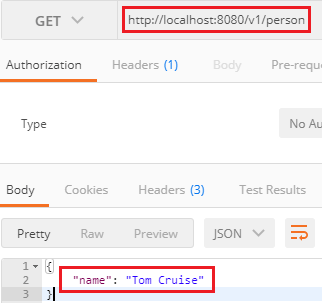
Change the URI http://localhost:8080/v2/person for the second version. It returns the firstName and lastName separately, as shown in the following image. 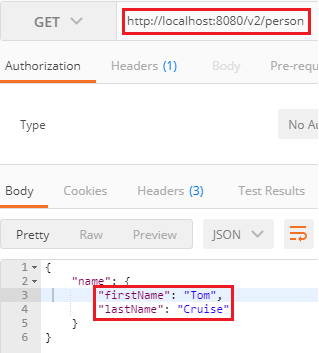
Versioning using Request ParameterAnother way to implement versioning is by using the request parameter. Amazon uses the request parameter versioning. Open the PersonVersioningController.java and do the following changes:
Both the methods have the same get mapping, so we will distinguish them by using the value and params attribute. The value attribute contains the URI, which we want to use, and the params attribute contains the parameter which distinguishes between versions. PersonVersoningController.java Now, move to Postman and send a GET request with the URI http://localhost:8080/person/param?version=1. It returns the full name, as shown in the following image. 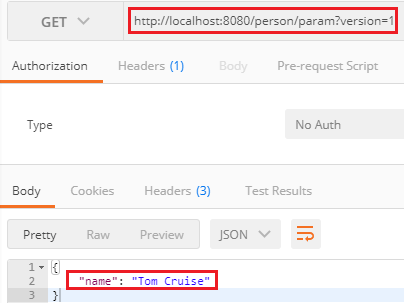
Again, generate a GET request with the URI http://localhost:8080/person/param?version=2 to access the second version. It returns the firstName and lastName separately, as shown in the following image. 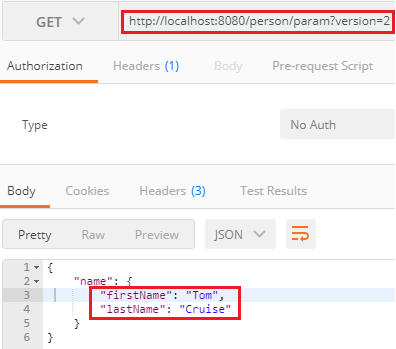
Versioning using Request HeaderThere is another option to do versioning using the Request Header. It is similar to content negotiation. In this method, we differentiate service based on the Request Header. In the PersonVersioningController.java, do the following:
Open the Postman:
It returns the name full name. 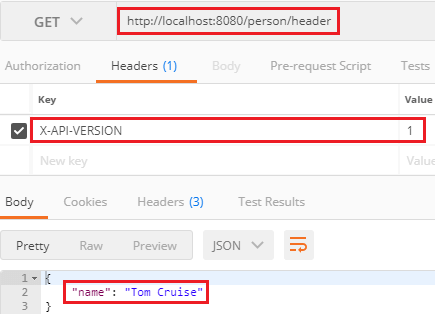
Let's send a GET request for version 2. For this, we need to change the value from 1 to 2 under the Headers tab. It returns the firstName and lastName separately. 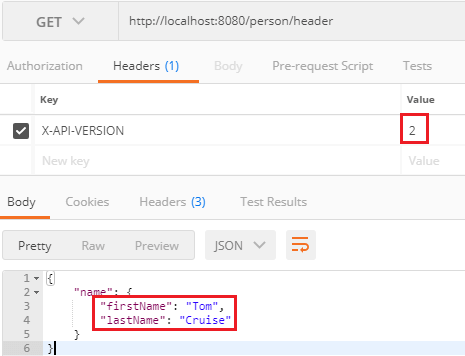
Versioning using Accept HeaderAnother method that is used in versioning is the Accept Header. It is also known as Content Negotiation or Accept Versioning. In this method, we use an attribute called produce. It denotes what kind of output we are generating for the specific service. In the PersonVersioningController.java file, do the following:
Open the Postman:
It returns the full name. 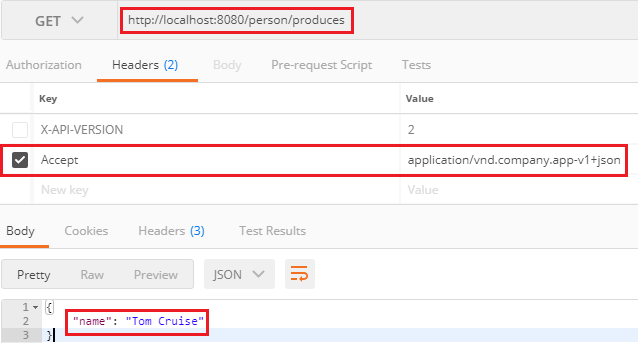
Let's send a GET request for version 2. For this we need to change the value from Value: application/vnd.company.app-v1+json to Value: application/vnd.company.app-v2+json. It returns the firstName and lastName separately. 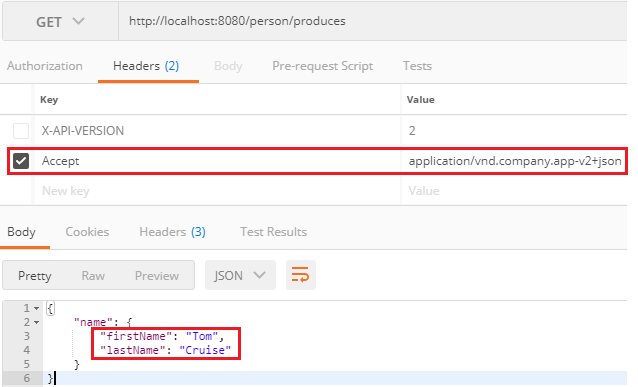
|
 For Videos Join Our Youtube Channel: Join Now
For Videos Join Our Youtube Channel: Join Now
Feedback
- Send your Feedback to [email protected]
Help Others, Please Share










